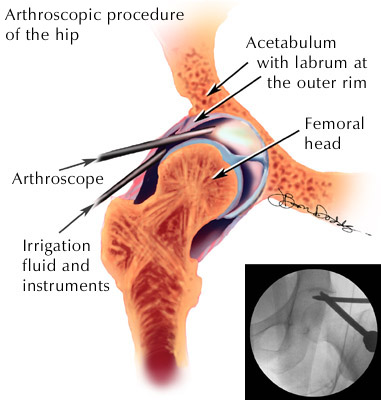|
|
||||||||||||||
|
|
Hip ArthroscopyWhat is hip arthroscopy?Hip arthroscopy is key-hole surgery on the hip joint. It is performed through small (2cm) incisions using a camera to visualize the inside of a joint. Traction is needed to created a space in the hip to insert the instruments.  Patients with the following problems can benefit from hip arthroscopy Labral Tear The labrum of the hip is a lip of thick cartilage that runs around the edge of the hip socket. When a labral tear of the hip occurs, the torn tissue can become pinched in the joint causing pain and catching sensations. Labral tears can occur from acute injuries such as sport or as a chronic problem due to impingement of the hip  A labral tear of the hip seen from the arthroscope Hip impingement Impingement of the hip is when the shape of the hip bones causes repetitive injury to the labrum and the cartilage lining the joint. This results in hip pain and may be one of the factors that lead to arthritis. Treatment involved reshaping of the bones inside the hip. Sometimes cartilage within the hip is also affected and this can be treated at the same time. (more info). The following video shows how hip arthroscopy can treat the abnormal shape of the femoral head by reshaping, often called femoral osteochondroplasty. Loose Bodies Loose bodies are pieces of cartilage that form within the joint. They look like small marbles floating within the joint space. These loose bodies can become caught within the hip during movements. Snapping Hip Syndrome Snapping hip syndrome has several causes, some of which can be treated with hip arthroscopy. If something is catching within the hip joint, hip arthroscopy can be used to relieve this snapping. Also, hip arthroscopy can be used to perform a psoas tendon release in cases of internal snapping hip syndrome. Diagnosis Most of the hip conditions that can be treated with hip arthroscopy present with either groin pain, buttock or thigh pain and sometimes with mechanical symptoms of clicking, catching or snapping in the hip which can be painful. Duration of symptoms can vary from only a few weeks after an injury to many years. Often patients have consulted many different doctors before referral is forthcoming. One of the diagnostic difficulties is that standard x-rays of the hip are generally normal and often MR arthrogram of the hip is used to investigate these problems. The symptoms described above can often be precipitated during examination by so called impingement testing - that is flexion to 90 degrees and internal rotation of the hip. Other movements during examination of the hip can also precipitate pain or clicking. What are the possible complications from hip arthroscopy? Complications following hip arthroscopy are uncommon. However the most concerning have to do with several important nerves and blood vessels that surround the joint. Nerve injury is uncommon, but can be a significant problem. The most commonly affected nerves include the lateral femoral cutaneous nerve (sensation to the thigh) and much less commonly the sciatic nerve. Injury to any of the nerves can cause pain and other problems. Other possible complications from hip arthroscopy include infection, blood clots, traction injuries and continued pain after the surgery. one exceptionally rare but devastating complication is AVN of the femoral head (bone death due to interrupted blood supply) leading to hip replacement. The rate of these complications is low, but patients need to understand the potential risk prior to undergoing a hip arthroscopy. Rehab after hip arthroscopy In the first few weeks after surgery, patients are often instructed to keep some weight off the hip, particularly if the bone has been reshaped. Work on regaining motion around the joint, and gentle strengthening exercises start early on. Typically, patients work with a physiotherapist for advice with exercises and stretches. Most patients can begin light activities (cycling, swimming) within a few weeks. Athletes most often take about 12 weeks to start more rigorous training. Full recovery can take 6 months and is dependent of the duration of symptoms before surgery. Benefits for patients Hip arthroscopy has been proven in published papers to be effective at relieving pain from labral tears, loose bodies and impingement. The patients that do not do so well are those with significant arthritic change and hip replacement may be more appropriate depending on the level of symptoms. References: Philippon et al JBJS 2009;91B:16-23 (last updated 24/11/09 TB) |
| Medical Marketing by Blue Medical |








